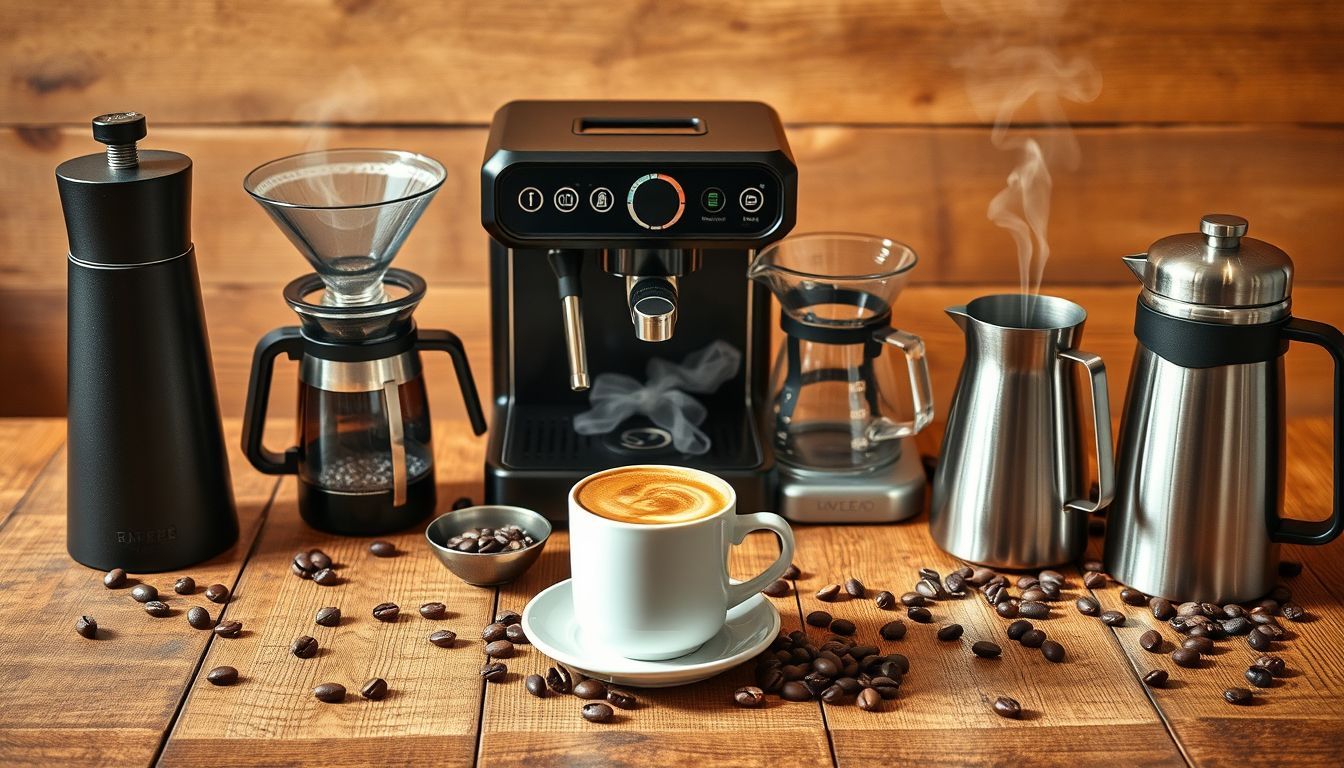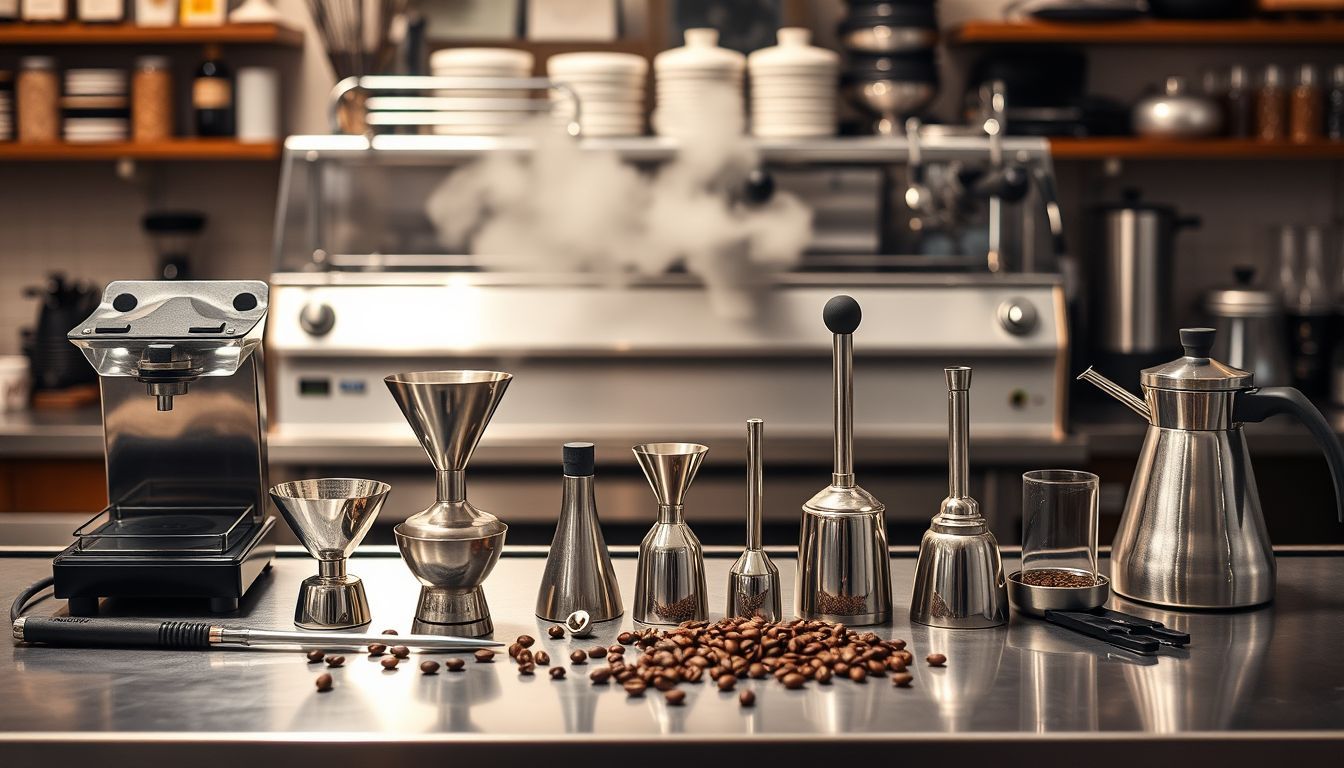Best Coffee Equipment for People with Arthritis or Hand Issues
Hand pain shouldn't mean giving up great coffee. I've found equipment designed for comfort and ease of use that delivers excellent results without strain or discomfort.

Amazon Affiliate Disclosure
This post contains affiliate links. If you purchase through these links, we may earn a small commission at no additional cost to you.
Hey coffee friends! Imani here, and I want to share something close to my heart. Last year, my regular customer Dorothy stopped coming in for her daily coffee. When I finally called to check on her, she told me her arthritis had gotten so bad that she couldn't operate her coffee maker anymore. "I miss good coffee," she said quietly, "but everything hurts my hands now."
That conversation changed how I think about coffee equipment. Dorothy isn't alone – millions of coffee lovers deal with arthritis, carpal tunnel, joint pain, or other hand issues that make traditional coffee brewing challenging or painful. But here's what I've learned: hand limitations don't have to mean giving up great coffee.
Over the past year, I've researched, tested, and worked with customers to find coffee equipment that's genuinely accessible. Not just "easier to use," but designed with comfort, reduced strain, and pain-free operation in mind. Today, I'm sharing the equipment that's helped customers like Dorothy get back to enjoying excellent coffee without the pain.
Because everyone deserves great coffee, regardless of what their hands can or can't do.
Understanding the Challenges
Common Hand and Wrist Issues That Affect Coffee Making
Arthritis: Joint pain, stiffness, and reduced grip strength
Carpal tunnel syndrome: Numbness, tingling, and weakness in hands
Tendonitis: Inflammation and pain in tendons
General joint pain: From injury, age, or medical conditions
Reduced dexterity: Difficulty with fine motor movements
Grip strength issues: Trouble holding or squeezing objects
How Traditional Coffee Equipment Can Be Problematic
Heavy lifting: Large water reservoirs and full carafes
Tight grips: Small handles and knobs
Repetitive motions: Grinding, stirring, pressing
Fine motor skills: Small buttons and precise movements
Pressure requirements: Tamping, pressing, squeezing
Hot surface contact: Risk of burns with reduced sensation
The Goal: Pain-Free Coffee Enjoyment
The equipment I'm recommending focuses on:
- Minimal hand strain and pressure
- Ergonomic design and comfortable grips
- Automated functions where helpful
- Lightweight construction
- Easy-to-operate controls
- Safety features for reduced sensation
The Accessibility Champions: My Top Equipment Picks
1. Programmable Drip Coffee Maker with Large Controls
Why It's Perfect for Hand Issues
A quality programmable drip maker eliminates most manual tasks. Set it up once, and it handles the brewing automatically. Look for models with large, easy-to-press buttons and comfortable handles.
Accessibility features:
- Large, clearly marked buttons
- Automatic brewing cycle
- Programmable timer
- Lightweight carafe with ergonomic handle
- No manual pressure or grinding required
Key Features to Look For
- Easy-grip carafe: Wide, comfortable handle that doesn't require tight gripping
- Large control panel: Buttons you can press with your palm or knuckles
- Auto shut-off: Safety feature for peace of mind
- Water level indicator: Easy to see without lifting reservoir
- Pause-and-serve: Pour a cup mid-brew without mess
Customer Success Story
My customer Robert has severe arthritis in his hands. After switching to a programmable drip maker with large controls, he told me: "Imani, I can make coffee again! I set it up the night before, and it's ready when I wake up. No pain, no struggle, just good coffee."
Recommended model:
We especially recommend the Cuisinart PerfecTemp 12 Cup Programmable Thermal Coffeemaker for its user-friendly carafe and large controls.
Investment: $100–150
Pain level: Minimal
Independence: High
2. Single-Serve Pod Machine with Touch Controls
The Ultimate Low-Impact Solution
Pod machines require minimal hand involvement. Modern versions with touch controls eliminate the need for gripping, twisting, or applying pressure.
Accessibility advantages:
- Touch-button operation
- No grinding or measuring
- Lightweight pods
- Automatic brewing
- No cleanup beyond rinsing
Features That Matter for Hand Comfort
- Touch controls: No pressure required, just light contact
- Large water reservoir: Less frequent refilling
- Automatic pod ejection: No manual removal needed
- Height-adjustable drip tray: Accommodates different cup sizes
- One-button operation: Minimal decision-making required
The Convenience Factor
Pod machines eliminate almost all manual tasks:
- No measuring coffee
- No handling filters
- No pouring hot water
- No cleanup of grounds
- No heavy lifting
Making Pod Coffee Better
- Choose quality pods: Invest in good coffee to maximize flavor
- Use filtered water: Improves taste and reduces mineral buildup
- Regular descaling: Automated cycles make this easy
- Keep variety: Different pods for different moods
Recommended model:
For solid accessibility, try the Keurig K-Elite Single Serve K-Cup Pod Coffee Maker with its intuitive interface and strength control.
Investment: $100–200
Pain level: Nearly zero
Convenience: Maximum
3. Electric Burr Grinder with Large, Easy Controls
For Those Who Want Fresh-Ground Coffee
If you want the benefits of fresh-ground coffee without hand strain, an electric burr grinder with accessibility features is essential.
Accessibility features:
- Large, easy-to-turn dial
- Push-button operation
- Automatic shut-off
- Easy-to-remove parts
- Minimal pressure required
What Makes a Grinder Hand-Friendly
- Large control dial: Easy to grip and turn
- Lightweight hopper: Easy to remove and fill
- Clear markings: Easy to see grind settings
- Stable base: Won't move during operation
- Easy cleaning: Removable parts for maintenance
Recommended model:
We love the Baratza Encore ESP Coffee Grinder for its straightforward controls and smooth grinding action.
Investment: $100–150
Pain level: Low
Coffee improvement: Significant
4. French Press with Ergonomic Handle and Easy-Press Design
The Gentle Manual Option
Modern French presses designed for comfort can be excellent for people with hand issues. Look for models with ergonomic handles and easy-press mechanisms.
Comfort features:
- Large, comfortable handle
- Smooth-pressing plunger
- Lightweight construction
- Heat-resistant materials
- Easy-pour spout
The Gentle Brewing Process
- Add coarse coffee (pre-ground is fine)
- Pour hot water (use electric kettle)
- Wait 4 minutes (no manual work)
- Press plunger gently (minimal pressure)
- Pour and enjoy
Why French Press Works for Hand Issues
- No fine motor skills required
- Minimal pressure needed for pressing
- Forgiving brewing method
- No filters to handle
- Easy to clean
Recommended model:
Consider the MuellerLiving French Press Coffee Maker 34oz for its double-insulated design and easy-press mechanism.
Investment: $30–60
Pain level: Low to moderate
Coffee quality: Excellent
5. Electric Kettle with Ergonomic Design
Safe, Comfortable Water Heating
An electric kettle with accessibility features eliminates the need to lift heavy pots or deal with stovetop safety concerns.
Accessibility features:
- Lightweight when empty
- Comfortable, large handle
- Easy-to-see water level
- Automatic shut-off
- Cool-touch exterior
Recommended model:
For precise control and effortless pouring, try the Fellow Stagg EKG Pro Electric Gooseneck Kettle with its adjustable temperature presets and ergonomic spout.
Investment: $150–200
Safety: High
Convenience: Excellent
6. Cold Brew Maker with Easy-Clean Design
The No-Heat, Low-Effort Option
Cold brew requires no hot water handling and minimal manual work. Modern cold brew makers are designed for easy use and cleaning.
Accessibility advantages:
- No hot water handling
- Minimal manual work
- Make once, drink all week
- Easy-to-remove filter
- Simple cleaning process
The Cold Brew Process
- Add coarse coffee to filter
- Add cold water
- Wait 12–24 hours
- Remove filter
- Store concentrate in fridge
Why Cold Brew Works
- No timing pressure
- No hot surfaces
- Batch preparation
- Smooth, low-acid coffee
- Customizable strength
Recommended model:
The Takeya Tritan Cold Brew Coffee Maker stands out for its easy-clean design and leak-proof lid.
Investment: $25–50
Effort level: Minimal
Batch convenience: High
Adaptive Accessories and Modifications
Grip Aids and Ergonomic Helpers
- Jar openers: For tight coffee containers
- Grip pads: Non-slip surfaces for better control
- Lever-style handles: Easier than twist mechanisms
- Weighted utensils: Better control for stirring
- Large-handle scoops: Easier to grip and control
Kitchen Modifications
- Counter height: Ensure comfortable working level
- Storage accessibility: Keep frequently used items within easy reach
- Good lighting: Important for safe operation
- Non-slip mats: Prevent equipment from sliding
- Organized setup: Minimize reaching and searching
Safety Considerations
- Temperature awareness: Use equipment with clear indicators
- Automatic features: Reduce need for monitoring
- Stable surfaces: Prevent spills and accidents
- Easy cleanup: Choose equipment that's simple to maintain
- Emergency shut-offs: Important safety features
Building Your Accessible Coffee Setup
Starting Simple
Begin with one piece of accessible equipment and build from there. A programmable drip maker or pod machine can provide immediate relief and good coffee.
The Gradual Approach
- First: Automated brewing (drip maker or pod machine)
- Second: Electric kettle for safety and convenience
- Third: Accessible grinder if fresh grinding is important
- Fourth: Additional brewing methods as interest and ability allow
Budget Considerations
Essential setup ($100–200): Programmable drip maker and electric kettle
Comfort upgrade ($200–400): Add accessible grinder and ergonomic accessories
Complete system ($400–600): Multiple brewing options and full accessibility features
Working with Healthcare Providers
Consult with occupational therapists or healthcare providers about:
- Specific equipment recommendations
- Adaptive techniques
- Safety considerations
- Ergonomic setup advice
Tips for Pain-Free Coffee Preparation
General Principles
Pace yourself: Don't rush through preparation
Use both hands: Distribute weight and effort
Take breaks: Rest between steps if needed
Stay organized: Minimize reaching and searching
Plan ahead: Prep what you can in advance
Specific Techniques
Water handling: Use smaller amounts, refill more frequently
Coffee storage: Transfer to smaller, easier-to-handle containers
Cleanup: Clean as you go to prevent buildup
Temperature safety: Always be aware of hot surfaces
Assistance: Don't hesitate to ask for help with setup
Pain Management
Warm-up: Gentle hand exercises before coffee preparation
Timing: Make coffee when hands feel best
Medication: Consider timing with pain medication
Rest: Stop if pain increases
Alternatives: Have backup options for difficult days
The Community Aspect
Finding Support
Connect with others who share similar challenges:
- Online communities for people with arthritis
- Local support groups
- Occupational therapy resources
- Adaptive equipment specialists
Sharing Solutions
What works for one person might help another. Share your discoveries and learn from others' experiences.
Professional Resources
Occupational therapists: Experts in adaptive techniques
Medical equipment suppliers: Specialized adaptive tools
Arthritis organizations: Resources and support
Online forums: Real-world experiences and tips
Your Accessible Coffee Journey
Here's what I want you to remember: having hand issues doesn't mean giving up great coffee. It means finding the right tools and techniques that work for your specific needs and limitations.
The equipment I've shared today has helped dozens of my customers continue enjoying excellent coffee despite arthritis, carpal tunnel, and other hand challenges. Each person's needs are different, but there are solutions available.
Start with what feels most manageable for you. Maybe it's a simple pod machine that eliminates all manual work. Maybe it's a programmable drip maker that handles the brewing automatically. Maybe it's an ergonomic French press that lets you maintain some hands-on involvement.
The goal isn't to find the "perfect" solution – it's to find YOUR solution. The one that gives you great coffee without pain, frustration, or giving up the ritual you love.
Don't let anyone tell you that accessible coffee equipment means compromising on quality. Some of the best coffee I've ever tasted came from the simple setups my customers with hand issues have developed.
What challenges are you facing with your current coffee routine? Are there specific tasks that cause pain or difficulty? Come by the café and let's talk about solutions that might work for your situation. I'm always learning from my customers about what works and what doesn't.
Remember: you deserve great coffee, and there's always a way to make it happen comfortably and safely.
Here's to pain-free coffee enjoyment,
Imani
P.S. – If you're local and want to try any of these accessible coffee makers before purchasing, let me know! I keep several models available for customers to test, and I'm always happy to help you find equipment that works for your specific needs.

Imani Wells
For years, I found stories in the steam of the espresso machine and the conversations buzzing around my coffee shop. Now, I have the profound joy of putting those everyday moments of connection onto the page for you.


